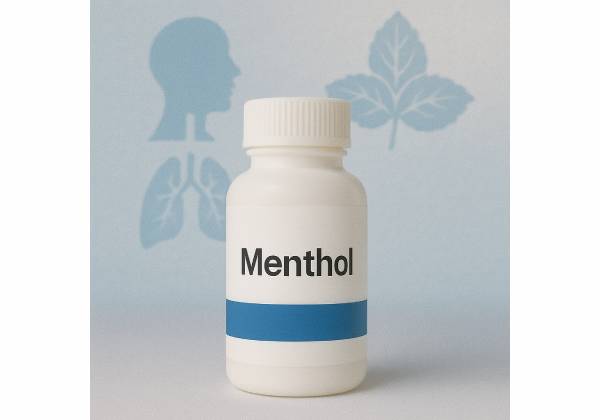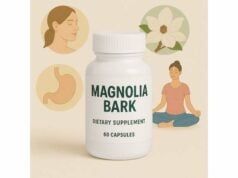
Menthol is the cooling compound that gives peppermint its signature feel—and it is more than a flavor. As a topical counterirritant and sensory modulator, menthol can ease minor muscle and joint aches, calm itch, and soothe a cough or scratchy throat. It does this primarily by activating cold-sensing nerve channels, which can both “distract” from pain and trigger local analgesia. It appears in familiar over-the-counter (OTC) formats: creams, gels, patches, vapor rubs, nasal products, and lozenges. Concentration matters: low percentages cool and comfort; higher amounts can irritate. Used as directed, menthol is generally safe for adults and older children, though it still demands basic precautions—especially around infants, sensitive skin, and mucous membranes. This guide distills how menthol works, where it helps (and where it does not), practical dosing by product type, and who should avoid it. You will find straightforward, label-aligned instructions for real-world use, plus evidence-based notes on what to expect.
Fast Facts
- Topical menthol can temporarily relieve minor muscle and joint pain and reduce itch when used in approved concentrations.
- Lozenges with menthol (5–10 mg per lozenge) can temporarily ease cough and throat irritation.
- Use topical menthol 1.25–16% up to 3–4 times daily; for vapor rubs 2.6–2.8% up to 3 times daily; do not apply to broken skin.
- Possible side effects include burning, stinging, or rash; stop use if irritation or worsening occurs.
- Avoid in infants under 2 years for topical chest/neck use; avoid applying near the nose of young children; people with very sensitive skin or fragrance allergies should test a small area first.
Table of Contents
- What is menthol and how does it work?
- What benefits does menthol provide?
- How to use menthol safely and effectively
- How much menthol should you use? Dosage guide
- Who should avoid menthol and key risks
- What does the evidence say overall?
What is menthol and how does it work?
Menthol is a naturally occurring monoterpene alcohol found in mint oils, especially peppermint. In consumer health, it is used in topical analgesics, itch-relief products, throat lozenges, vapor rubs, dental and oral-care products, and certain nasal preparations. While its cooling feel is unmistakable, the key to menthol’s effects lies in how it talks to your sensory nerves.
The primary target is TRPM8 (transient receptor potential melastatin 8), a cold-sensing ion channel on peripheral sensory neurons in the skin, mouth, and airways. When menthol binds to TRPM8, the channel opens and allows cations to flow, generating a “cool” signal—even without a drop in temperature. This signal competes with and can dampen heat and pain messages, producing a local analgesic effect. At appropriate concentrations, that translates into reduced discomfort from strains, sprains, simple backache, and overuse injuries. It can also lessen itch by modulating cutaneous sensory receptors involved in pruritus.
Menthol’s actions are concentration-dependent. Low to moderate strengths tend to soothe; higher strengths can sensitize cold pathways and feel uncomfortably intense, even burning. This “paradox” is part pharmacology (stronger activation can heighten sensitivity) and part chemistry (menthol also interacts with other receptors such as TRPA1 and voltage-gated sodium channels). Product labels reflect this reality: analgesic/antipruritic menthol appears in the low range (fractions of a percent up to ~1%), while counterirritant pain rubs may contain several percent, trading a stronger sensory “signal” for short-term relief.
In the upper airways, menthol stimulates cold receptors in nasal mucosa and the oropharynx, which can improve the subjective sensation of airflow and decrease the urge to cough. In lozenges, menthol serves as a cough suppressant and oral anesthetic to ease minor throat irritation. Again, perception is the point: menthol does not “shrink” nasal tissues or clear mucus mechanically, but it can make breathing feel easier and a sore throat feel less raw while you recover.
Finally, formulation matters. A 2.6–2.8% menthol vapor rub is designed for chest and throat application to release inhalable vapors. A 1.25–16% counterirritant cream is built to penetrate the skin over muscles and joints. A 5–10 mg lozenge is calibrated to dissolve slowly and deliver a steady, localized effect. Understanding these use-cases helps you pick the right tool for the job and apply it correctly.
What benefits does menthol provide?
Short-term pain relief for minor musculoskeletal aches. When rubbed onto the skin over sore muscles or joints, menthol can reduce discomfort from strains, sprains, simple backache, and sports overuse. The relief is temporary—think hours, not days—but often fast. Many people pair a menthol rub with rest, gentle movement, and heat/ice cycles for day-to-day symptom control while the underlying tissue heals.
Cooling comfort for itch. Menthol depresses cutaneous sensory receptors involved in pruritus, providing a non-steroidal option for occasional itch from insect bites, minor rashes, or dry skin. Because menthol’s effect is sensory, it pairs well with moisturizers and avoids the rebound risks of overusing topical steroids in mild itch situations. For persistent or inflamed rashes, you still need a diagnosis and targeted therapy.
Less cough and throat irritation—temporarily. Lozenges that contain 5–10 mg of menthol can quiet a tickly cough and reduce the raw, scratchy sensation associated with a viral upper-respiratory infection or environmental irritants. Vapor rubs (2.6–2.8% menthol) applied to the chest and throat release soothing vapors; the sensory “cool” can improve the feeling of nasal airflow and the urge-to-cough threshold. Lozenges and vapor rubs do not treat infection; they make symptoms more tolerable while your body clears the cause.
Adjunct to athletic recovery. For some, the brisk cooling and mild counterirritation of menthol creams or roll-ons provide a helpful bridge after training—particularly when deep heat is uncomfortable or contraindicated. Cooling can be preferable for heat-intolerant users or warm climates. Relief is subjective and varies with concentration, application technique, and expectations.
Oral-care comfort. In oral-care products (under separate monographs), menthol contributes not just flavor but a mild numbing and freshening effect, which can briefly ease minor mouth irritation. These products are formulated for the oral environment; concentrated essential oils or non-oral formulations should not be swallowed.
What menthol cannot do. It does not repair tissue, resolve arthritis, or cure respiratory infections. It is not a substitute for anti-inflammatory drugs when those are indicated; rather, it is a sensory tool that can complement them. Overuse, especially at high strengths or on sensitive skin, can sting or worsen irritation. Using menthol near the eyes or on mucous membranes is a common mistake and usually results in a sharp, unpleasant burn.
Where menthol fits. Think of menthol as a low-risk, quick-acting comfort measure: helpful for minor aches, post-workout discomfort, simple strains, bug bites, and irritating coughs. It works best when you match the product to the task (cream or gel for muscles and joints; lozenge for cough; vapor rub for chest and throat) and respect label directions on frequency and total exposure.
How to use menthol safely and effectively
Pick the right format for your goal.
- For muscle or joint pain: Choose a counterirritant cream, gel, stick, or roll-on labeled for aches and pains. Typical menthol range is 1.25–16%. Higher numbers feel colder and can tingle or burn; lower numbers feel milder.
- For itch relief: Look for analgesic/antipruritic products where menthol is typically 0.1–1%, often combined with other soothing agents (e.g., camphor or skin protectants).
- For cough/scratchy throat: Use a menthol lozenge with 5–10 mg menthol. Let it dissolve slowly; avoid chewing or swallowing whole.
- For chest and throat comfort from colds: A vapor rub with menthol 2.6–2.8% is applied to the chest and throat only, up to three times daily.
Apply it the smart way.
- Patch test first on a small area if you have sensitive skin, eczema, or fragrance allergies. Wait 24 hours to check for rash or unusual burning.
- Measure, do not glob. A thin, even layer is enough for creams and gels. More product does not equal more relief and raises irritation risk.
- Target the area. For muscles or joints, rub over and slightly beyond the most tender region. Wash hands after applying to avoid transferring menthol to eyes or nose.
- Respect frequency. For topical analgesic/counterirritant products, do not exceed 3–4 applications per day. For vapor rubs, up to 3 times daily is standard. For lozenges, you may repeat about every hour as needed—but align with the product’s label and your overall intake.
- Avoid broken or irritated skin. Do not use over wounds, abrasions, sunburn, or dermatitis flares. Menthol can sting and worsen inflammation.
- Keep away from the eyes and mucous membranes. If accidental contact occurs, rinse with copious cool water; do not rub.
- Do not occlude. Avoid tight bandages or plastic wrap over menthol creams; occlusion can intensify sensation and increase irritation.
- Layering with heat or cold. Many people combine menthol with ice or gentle heat. Try one at a time first. If you add a heating pad later, use low heat and monitor closely to avoid burns, especially with higher-strength menthol.
Special tips for common scenarios.
- Post-workout soreness: Start with 3–5% menthol gel or roll-on to large muscles (quads, calves, back). Reassess after 20–30 minutes; reapply later if needed within daily limits.
- Office/desk neck tension: A low-mess stick or roll-on reduces transfer to hands and clothing.
- Night cough: One menthol lozenge before bed can reduce throat tickle. If you prefer vapor rubs, apply to chest and throat and keep clothing loose at the neck so vapors can be inhaled.
- Itchy insect bites: A dab of low-strength menthol can break the scratch cycle. If redness and swelling expand or you see signs of infection, seek care.
When to stop or switch. If burning or stinging persists beyond a short initial tingle, if a rash develops, or if pain worsens after use, stop and choose a different approach (e.g., non-menthol topical, oral analgesic, or medical evaluation).
How much menthol should you use? Dosage guide
Topical pain and itch products (skin):
OTC labeling for external analgesics sets two relevant menthol ranges:
- Analgesic/antipruritic: 0.1–1% menthol.
- Counterirritant pain relief: 1.25–16% menthol.
Directions: For adults and children ≥ 2 years, apply to the affected area not more than 3 to 4 times daily. For children < 2 years, do not use unless a clinician advises. Never apply to wounds or damaged skin, and avoid tight bandaging.
Chest and throat vapor rubs (topical inhalation):
Many chest rubs contain 2.6–2.8% menthol (sometimes with camphor). The standard directions are up to 3 times daily, applied to chest and throat only, with clothing loose around the neck to let vapors reach the nose and mouth. Do not apply in or near the nostrils, and do not use on children under 2 years unless a clinician advises.
Menthol lozenges (cough suppressant/oral anesthetic):
Each lozenge typically contains 5–10 mg menthol. Let one lozenge dissolve slowly in the mouth; may repeat about every hour as needed or per label. Children under 2 years should not use menthol lozenges unless a clinician advises. As with any cough remedy, persistent cough (> 1 week), high fever, shortness of breath, or thick green/bloody mucus signals a need for evaluation.
Combining products safely.
It is common to combine a menthol pain rub for a sore shoulder with a menthol lozenge for a cold. The mechanisms and exposure routes differ, but be mindful of total skin exposure (do not layer multiple high-strength menthol products over the same area) and co-ingredients (e.g., methyl salicylate in some rubs carries its own limits). When in doubt, choose one menthol topical at a time and space applications.
Practical examples.
- Mild calf strain: 4% menthol gel, thin layer after activity; repeat 8–12 hours later if needed; maximum 3–4 times daily.
- Simple backache after yard work: 5–10% menthol cream to lumbar area morning and evening; skip if skin becomes irritated.
- Nighttime tickly cough: One 5–10 mg lozenge pre-bed; if cough wakes you, you may repeat, staying within product directions.
- Itchy mosquito bites: 0.5% menthol lotion, small dab as needed up to 3–4 times daily.
When to escalate care.
If pain persists beyond 7 days, repeatedly returns, or is accompanied by swelling, warmth, or limited range of motion, seek medical assessment. If cough persists beyond one week, is accompanied by fever or chest pain, or occurs with chronic lung disease, seek care rather than relying on menthol alone.
Who should avoid menthol and key risks
Infants and very young children. Do not apply menthol chest rubs to children under 2 years without a clinician’s advice. Never apply mentholated products in or just under a child’s nose. Young children can react strongly to intense vapors with eye irritation, coughing, or distress.
Broken or inflamed skin. Avoid menthol on wounds, eczema flares, sunburn, or open blisters. The product can sting, slow healing, and provoke further irritation. Resume only after the skin barrier is intact.
History of fragrance or topical allergy. Menthol is a fragrance component. People with contact dermatitis to fragrances or mint oils may react. If you must try menthol, perform a 24-hour patch test on a small area first.
High-strength overuse. Concentrated counterirritants (upper single-digit to mid-teens percent) can cause cold allodynia (painful cold sensation), burning, or paradoxical irritation—especially under occlusion or on thin skin (neck, inner arm). Use the lowest effective strength and avoid tight wraps.
Sensitive areas and mucous membranes. Menthol near the eyes, in the nostrils, or on the genitals can burn intensely. If exposure occurs, flush copiously with cool water; do not rub. For male genital desensitizing sprays (separate category), follow label directions strictly and discontinue if irritation occurs.
Drug and product combinations. Many topical pain products combine menthol with methyl salicylate or camphor. Each component adds its own risks (e.g., salicylate overuse across large areas; camphor toxicity if ingested). Do not stack multiple rubs together or exceed labeled frequencies.
Pregnancy and breastfeeding. Topical menthol used as directed is generally considered low risk, but robust data are limited. Avoid application to the breast when nursing, and avoid infant exposure to vapors. If you are pregnant or lactating, discuss any routine use with your clinician.
Ingestion of concentrated oils. Menthol is not a DIY oral supplement. Do not ingest essential oils or concentrated menthol. Only use formulated lozenges as labeled.
When to stop immediately. Stop and seek care if you experience a spreading rash, wheeze or throat tightness, facial swelling, dizziness, or severe burning that does not subside after washing off the product.
Storage and safety. Keep menthol products out of children’s reach. Menthol-containing balms are attractive scents to kids; accidental ingestion can be harmful. Store tightly capped, at room temperature, away from heat sources.
What does the evidence say overall?
Mechanism is well characterized. The cooling sensation and much of menthol’s analgesic action trace to TRPM8 activation on peripheral sensory neurons. Experimental work clarifies not only how menthol opens this channel but also how concentration, voltage, and co-factors modulate the response. This mechanistic clarity explains why menthol can both soothe at moderate levels and provoke cold sensitivity at high levels, and why product concentration and use-case matter.
Clinical relief is real but modest and situational. For minor musculoskeletal pain, topical menthol provides short-term relief for many users. Effects are felt quickly and may be strongest where a strong sensory signal is desirable (e.g., post-exercise soreness). Relief tends to fade within hours, so repeated applications within labeled limits are common. In itch, low-strength menthol can help interrupt the scratch cycle. In cough and throat irritation, menthol lozenges (5–10 mg) and vapor rubs (2.6–2.8% menthol) offer symptomatic relief by reducing the urge to cough and improving the perception of airflow and throat comfort.
Regulatory clarity supports safe use. U.S. OTC monographs specify menthol’s legal concentration ranges for each indication and tighten labeling around warnings and directions. That is why most pain rubs fall between 1.25–16% and why labels consistently limit topical use to 3–4 times per day. The same framework defines lozenge strength and directions, keeping dosing consistent across brands.
Safety profile is favorable when labels are followed. The most common adverse events—transient burning, stinging, or rash—usually resolve by stopping the product. Risk rises with higher concentrations, occlusion, frequent reapplication, and use on thin or compromised skin. Pediatric cautions reflect sensitivity to vapors and the importance of keeping menthol away from the nose and mouth of young children.
Open questions. Researchers continue to probe how TRPM8 integrates with other channels and pain pathways, and whether targeting TRPM8 more precisely can yield new analgesics. For everyday use, the biggest knowledge gaps are not mechanism but best-practice application in specific populations (e.g., older adults with thin skin, people with neuropathic pain) and the additive effects of combining menthol with other topical actives or modalities.
Bottom line. Menthol is a useful, fast-acting, sensory-based tool. If you match the formulation and strength to your goal, apply within labeled frequency, and avoid sensitive use-cases (infants, broken skin, eyes/nose), you can expect meaningful—though temporary—relief with a low risk of problems.
References
- The distinctive role of menthol in pain and analgesia: Mechanisms, practices, and advances 2022 (Systematic/Mechanistic Review)
- Molecular determinants of TRPM8 function: key clues for a cool modulation 2023 (Review)
- Final Administrative Order (OTC000033): Over-the-Counter Monograph M017: External Analgesic Drug Products for Over-the-Counter Human Use 2023 (Guideline/Monograph)
- 21 CFR Ch. I (4–1–25 Edition) § 341.74 2025 (Guideline)
- Over-the-Counter Monograph M012: Cold, Cough, Allergy, Bronchodilator, and Antiasthmatic Drug Products for OTC Human Use 2022 (Guideline/Monograph)
Disclaimer
This article is for general information only and is not a substitute for professional medical advice, diagnosis, or treatment. Always follow the directions on your product label and consult a qualified health professional about your specific symptoms, medications, and conditions—especially for children, pregnancy or breastfeeding, chronic illnesses, or if symptoms are severe or persistent.
If you found this guide helpful, please consider sharing it on Facebook, X (formerly Twitter), or your favorite platform, and follow us on social media. Your support helps us continue creating clear, reliable health content. Thank you.










